Una sitemap XML agisce come una tabella di marcia per i motori di ricerca, guidandoli verso tutte le pagine e i contenuti importanti del vostro sito web. Questo li aiuta a scoprire e indicizzare i vostri contenuti in modo più efficiente, garantendo la visibilità del vostro sito web nei risultati di ricerca.
Su WPBeginner, utilizziamo All in One SEO per generare automaticamente sitemap XML e per avere un maggiore controllo, come la possibilità di escludere alcune tassonomie. Tuttavia, abbiamo cercato altri modi per creare sitemap per WordPress, in modo che possiate scegliere il metodo più adatto al vostro sito web.
In questo articolo spiegheremo cos’è una sitemap XML e come potete creare facilmente una sitemap in WordPress. Vi spiegheremo come farlo con e senza plugin e vi mostreremo come inviare la vostra sitemap ai motori di ricerca in modo che il vostro sito venga indicizzato più velocemente.
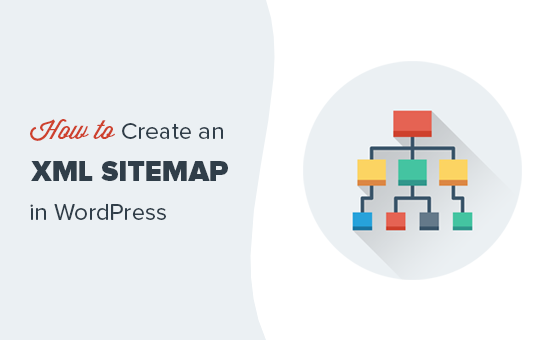
Che cos’è una Sitemap XML?
Una sitemap XML è un file che elenca tutti i contenuti del vostro sito web in un formato XML, in modo che i motori di ricerca come Google possano facilmente scoprire e indicizzare i vostri contenuti.
All’inizio degli anni 2000, i siti web governativi avevano un link sulla pagina principale intitolato “Sitemap”. Questa pagina di solito conteneva un elenco di tutte le pagine importanti del sito web.
Sebbene alcuni siti web abbiano ancora oggi pagine sitemap in HTML, l’uso generale delle sitemap si è evoluto nel corso degli anni.
Oggi le sitemap sono pubblicate in un formato file XML invece che in HTML e il loro pubblico di riferimento sono i motori di ricerca e non le persone.
Fondamentalmente, una sitemap XML è un modo per i proprietari di siti web di indicare ai motori di ricerca tutte le pagine esistenti sul loro sito.
Indica inoltre ai motori di ricerca quali link sono più importanti di altri e la frequenza di aggiornamento del sito.
Sebbene le sitemap XML non aumentino le classifiche dei motori di ricerca, esse consentono ai motori di ricerca di effettuare una migliore scansione del sito web. Ciò significa che possono trovare più contenuti e iniziare a mostrarli nei risultati di ricerca, con conseguente aumento del traffico di ricerca e miglioramento delle classifiche SEO.
Perché è necessaria una Sitemap XML
Le sitemap sono estremamente importanti dal punto di vista dell’ottimizzazione dei motori di ricerca (SEO).
La semplice aggiunta di un file sitemap non influisce sulle classifiche di ricerca. Tuttavia, se sul vostro sito c’è una pagina che non è indicizzata, una sitemap permetterà ai motori di ricerca di sapere chi siamo.
Le sitemap sono estremamente utili quando si apre un blog o si crea un nuovo sito web, perché la maggior parte dei nuovi siti non ha backlink. Questo rende più difficile per i motori di ricerca scoprire tutti i vostri contenuti.
Per questo motivo i motori di ricerca come Google e Bing consentono ai proprietari di nuovi siti web di inviare una sitemap nei loro strumenti per webmaster. In questo modo i bot dei motori di ricerca possono scoprire e indicizzare facilmente i contenuti del sito (per saperne di più).
Le sitemap sono altrettanto importanti anche per i siti web affermati e popolari. Permettono di evidenziare quali parti del sito sono più importanti e quali vengono aggiornate più frequentemente, in modo che i motori di ricerca possano indicizzare i contenuti di conseguenza.
Detto questo, vediamo come creare una sitemap XML in WordPress.
Video tutorial
Se preferite le istruzioni scritte, continuate a leggere.
Esistono diversi modi per creare una sitemap XML in WordPress. Vi mostreremo tre metodi popolari per creare una sitemap XML in WordPress. Vi mostreremo anche come inviare le sitemap ai motori di ricerca e come utilizzarle per far crescere il vostro sito.
Metodo 1: Creare una Sitemap XML in WordPress senza un plugin
Questo metodo è molto elementare e limitato in termini di funzioni.
Prima dell’agosto 2020, WordPress non disponeva di sitemap integrate. Tuttavia, con WordPress 5.5 è stata rilasciata una funzione di sitemap XML di base.
Questa funzione consente di creare automaticamente una sitemap XML in WordPress senza utilizzare un plugin. È sufficiente aggiungere wp-sitemap.xml alla fine del vostro nome di dominio, in questo modo:
https://www.example.com/wp-sitemap.xml
WordPress mostrerà la sitemap XML predefinita.
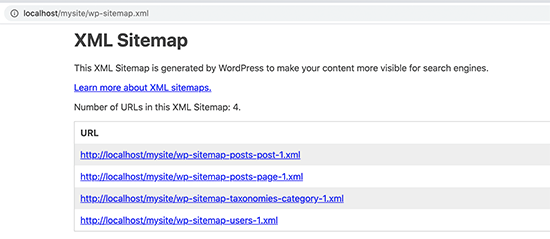
Questa funzione di sitemap XML è stata aggiunta a WordPress per garantire che ogni nuovo sito WordPress non perda i vantaggi SEO di una sitemap XML.
Tuttavia, non è molto flessibile e non è possibile controllare facilmente cosa aggiungere o rimuovere dalle sitemap XML.
Fortunatamente, quasi tutti i migliori plugin SEO per WordPress sono dotati di una propria funzionalità di sitemap. Queste sitemap sono migliori e potete controllare quali contenuti rimuovere o escludere dalle sitemap XML di WordPress.
Metodo 2: Creare una Sitemap XML in WordPress con AIOSEO
Il modo più semplice per creare una sitemap XML in WordPress è utilizzare il plugin All in One SEO (AIOSEO) per WordPress.
È il miglior plugin SEO per WordPress sul mercato, che offre un generatore di sitemap e una serie completa di strumenti per ottimizzare i post del blog per la SEO.
Per prima cosa, è necessario installare e attivare il plugin All in One SEO. Per maggiori dettagli, consultate la nostra guida passo passo su come installare un plugin di WordPress.
La funzione sitemap è disponibile anche nella versione gratuita di AIOSEO. Tuttavia, per ottenere sitemap avanzate di notizie e video, è necessaria la versione Pro.
Dopo l’attivazione, andare alla pagina All in One SEO ” Sitemaps per rivedere le impostazioni della sitemap.
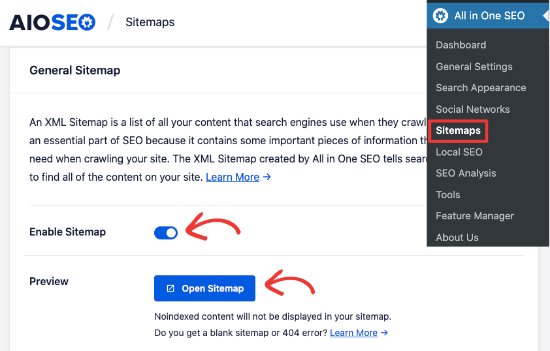
Per impostazione predefinita, All in One SEO abilita la funzione Sitemap e sostituisce le sitemap di base di WordPress.
È possibile fare clic sul pulsante “Apri Sitemap” per visualizzarne l’anteprima. È possibile visualizzare la sitemap anche aggiungendo sitemap.xml all’URL del sito web, come ad esempio:
https://www.example.com/sitemap.xml

Per i principianti non è necessario fare nulla, poiché le impostazioni predefinite funzionano per tutti i tipi di siti web, blog e negozi online.
Tuttavia, è possibile personalizzare le impostazioni della sitemap per controllare cosa includere nella sitemap XML.
È sufficiente scorrere verso il basso fino alla sezione “Impostazioni Sitemap”.

Questa sezione offre le opzioni per gestire gli indici delle sitemap e includere o escludere i tipi di post e le tassonomie(categorie e tag). È inoltre possibile abilitare le sitemap XML per gli archivi basati sulla data e gli archivi degli autori.
All in One SEO include automaticamente tutti i contenuti di WordPress nelle sitemap XML. Ma cosa succede se avete pagine autonome come un modulo di contatto, una landing page o pagine di negozi Shopify che non fanno parte di WordPress?
AIOSEO è l’unico plugin che consente di aggiungere pagine esterne alla sitemap di WordPress. Basta scorrere la sezione “Pagine aggiuntive” e attivarla. Verrà visualizzato un modulo in cui è possibile aggiungere le pagine personalizzate che si desidera includere.
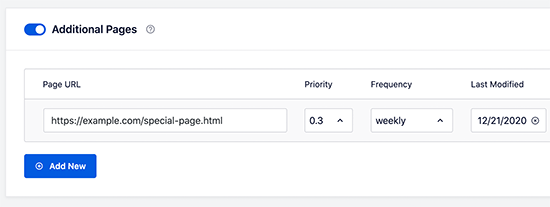
È sufficiente aggiungere l’URL della pagina che si desidera includere e impostare una priorità, dove 0,0 è la più bassa e 1,0 la più alta. Se non si è sicuri, si consiglia di usare 0.3.
Quindi, scegliere la frequenza degli aggiornamenti e la data dell’ultima modifica della pagina.
È possibile fare clic sul pulsante “Aggiungi nuovo” per aggiungere altre pagine.
Non dimenticate di fare clic sul pulsante “Salva modifiche” per memorizzare le impostazioni.
Esclusione di post e pagine specifici dalla Sitemap XML
All in One SEO consente di escludere qualsiasi post o pagina dalle sitemap XML. È possibile farlo facendo clic sulla sezione “Impostazioni avanzate” nella pagina All in One SEO ” Sitemaps.

È anche possibile rimuovere un post o una pagina dalle sitemap XML rendendoli no-index e no-follow. In questo modo i motori di ricerca non visualizzeranno quel contenuto nei risultati di ricerca.
È sufficiente modificare il post o la pagina che si desidera escludere e scorrere fino alla casella Impostazioni AIOSEO sotto l’editor.
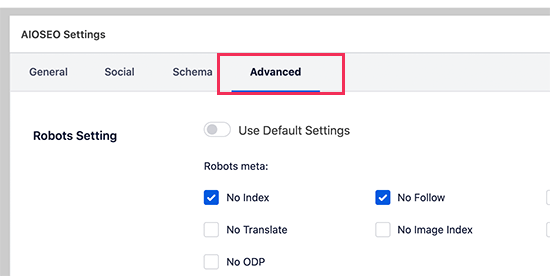
Da qui è necessario passare alla scheda Avanzate e selezionare le caselle accanto alle opzioni “Nessun indice” e “Nessun seguito”.
Creare Sitemaps aggiuntive
All in One SEO consente di creare sitemap aggiuntive, come quella dei video o delle notizie.
È possibile creare una sitemap video se si inseriscono regolarmente video nei post o nelle pagine del blog. In questo modo i motori di ricerca potranno visualizzare i post nei risultati di ricerca e i video insieme a una miniatura del video.
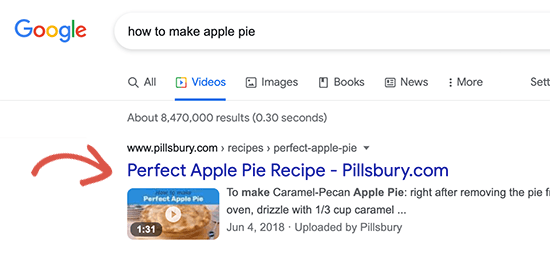
È inoltre possibile creare una sitemap News se si gestisce un sito web di notizie e si desidera apparire nei risultati di ricerca di Google News.
Basta andare su All in One SEO ” Sitemaps e passare alle schede Video Sitemap o News Sitemap per generare queste sitemaps.
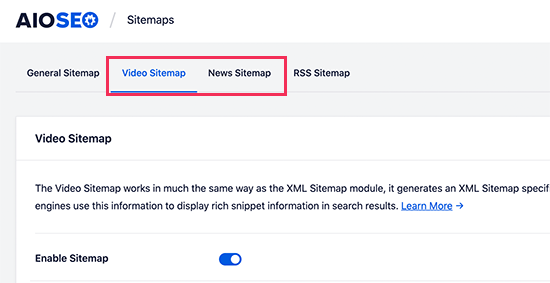
Nel complesso, AIOSEO è il miglior plugin per WordPress perché offre tutta la flessibilità e le potenti funzionalità a un prezzo molto conveniente.
Metodo 3: Creare una Sitemap XML in WordPress con Yoast SEO
Se utilizzate Yoast SEO come plugin per la SEO di WordPress, allora attiva automaticamente anche le sitemap XML.
Per prima cosa, è necessario installare e attivare il plugin Yoast SEO. Per maggiori dettagli, consultate la nostra guida passo passo su come installare un plugin di WordPress.
Dopo l’attivazione, andare alla pagina SEO ” Generale e passare alla scheda “Caratteristiche”. Da qui, è necessario scorrere verso il basso fino all’opzione “Sitemap XML” e assicurarsi che sia attivata.

Quindi, fare clic sul pulsante “Salva modifiche” per memorizzare le modifiche.
Per verificare che Yoast SEO abbia creato una sitemap XML, è possibile fare clic sull’icona del punto interrogativo accanto all’opzione “sitemap XML” nella pagina.
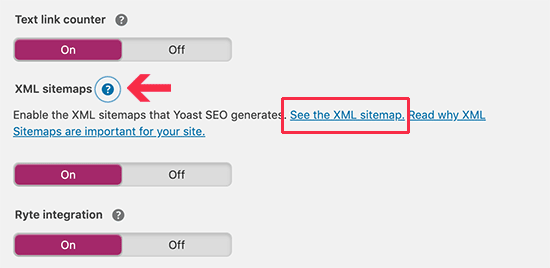
Successivamente, fare clic sul link “Vedi la Sitemap XML” per visualizzare la sitemap XML generata da Yoast SEO.
È possibile trovare la sitemap XML semplicemente aggiungendo sitemap_index.xml alla fine dell’indirizzo del sito web. Ad esempio:
https://www.example.com/sitemap_index.xml
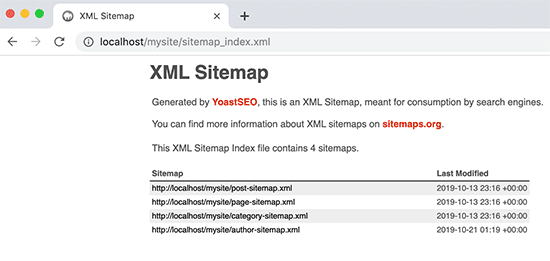
Yoast SEO crea sitemap multiple per diversi tipi di contenuto. Per impostazione predefinita, genera sitemap per post, pagine, autori e categorie.
Invio della Sitemap XML ai motori di ricerca
I motori di ricerca sono molto abili nel trovare una sitemap. Ogni volta che si pubblicano nuovi contenuti, viene inviato un ping a Google e Bing per informarli delle modifiche apportate alla sitemap.
Tuttavia, si consiglia di inviare la sitemap manualmente per garantire che i motori di ricerca la trovino.
Invio della Sitemap XML a Google
Google Search Console è uno strumento gratuito offerto da Google per aiutare i proprietari di siti web a monitorare e mantenere la presenza del loro sito nei risultati di ricerca di Google.
L’aggiunta della sitemap a Google Search Console aiuta a scoprire rapidamente i contenuti, anche se il sito è nuovo di zecca.
Innanzitutto, è necessario visitare il sito web di Google Search Console e registrare un account.
Successivamente, verrà chiesto di selezionare un tipo di proprietà. È possibile scegliere un dominio o un prefisso URL. Si consiglia di scegliere un prefisso URL, perché è più facile da configurare.

Inserite l’URL del vostro sito web e fate clic sul pulsante “Continua”.
Successivamente, vi verrà chiesto di verificare la proprietà del sito web. Verranno visualizzati diversi metodi per farlo. Si consiglia di utilizzare il metodo del tag HTML.

È sufficiente copiare il codice sullo schermo e poi andare nell’area di amministrazione del vostro sito WordPress.
Se si utilizza AIOSEO, la verifica degli strumenti per i webmaster è semplice. Basta andare su All in One SEO ” Impostazioni generali e poi fare clic sulla scheda “Strumenti per i Webmaster”. Dopodiché, è possibile inserire il codice di Google.

Se non si utilizza AIOSEO, è possibile inserire il codice utilizzando il plugin WPCode. Questo è il modo più sicuro e semplice per aggiungere codice al vostro sito WordPress.
È necessario installare e attivare il plugin gratuito WPCode. Per maggiori dettagli, consultate la nostra guida passo-passo su come installare un plugin di WordPress.
Dopo l’attivazione, è necessario visitare la pagina Code Snippets ” Header & Footer e aggiungere il codice copiato in precedenza nella casella “Header”.
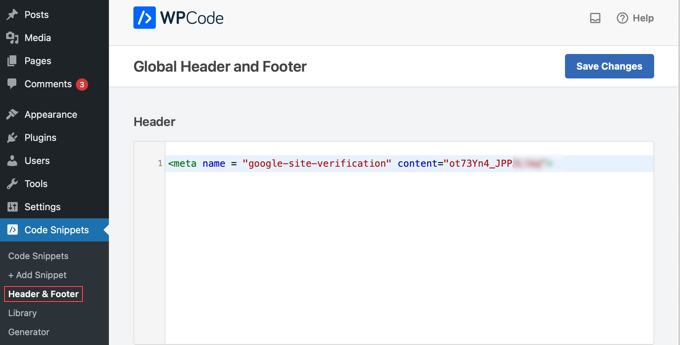
Non dimenticate di fare clic sul pulsante “Salva modifiche” per memorizzare le modifiche.
Ora, tornate alla scheda Google Search Console e fate clic sul pulsante “Verifica”.
Google verificherà la presenza di un codice di verifica sul vostro sito e lo aggiungerà al vostro account Google Search Console.
Nota: se la verifica non ha esito positivo, assicurarsi di cancellare la cache di WordPress e riprovare.
Ora che avete aggiunto il vostro sito web, aggiungete anche la vostra sitemap XML.
Dalla dashboard del vostro account, dovete cliccare su “Sitemaps” dalla colonna di sinistra.

Successivamente, è necessario aggiungere l’ultima parte dell’URL della sitemap nella sezione “Aggiungi una nuova sitemap” e fare clic sul pulsante “Invia”.
Google aggiungerà ora l’URL della sitemap alla Google Search Console.
Google impiegherà un po’ di tempo per effettuare il crawling del vostro sito web. Dopo un po’ di tempo, sarà possibile visualizzare le statistiche di base della sitemap.
Queste informazioni includono il numero di link che Google ha trovato nella vostra sitemap, quanti di essi sono stati indicizzati, il rapporto tra immagini e pagine web e altro ancora.
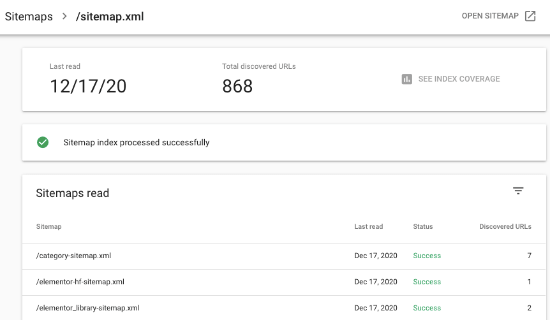
Invio della Sitemap XML a Bing
Analogamente a Google Search Console, anche Bing offre Bing Webmaster Tools per aiutare i proprietari di siti web a monitorare il proprio sito nel motore di ricerca Bing.
Per aggiungere la sitemap a Bing, è necessario visitare il sito web Bing Webmaster Tools.
Qui vengono visualizzate due opzioni per aggiungere il sito. È possibile importare il sito da Google Search Console o aggiungerlo manualmente.

Se avete già aggiunto il vostro sito a Google Search Console, vi consigliamo di importarlo. Si risparmia tempo perché la sitemap viene importata automaticamente.
Se si sceglie di aggiungere il sito manualmente, è necessario inserire l’URL del sito e verificarlo.
Bing vi chiederà ora di verificare la proprietà del vostro sito web e vi mostrerà diversi metodi per farlo.
Si consiglia di utilizzare il metodo dei tag meta. È sufficiente copiare la riga del meta tag dalla pagina e dirigersi verso la propria dashboard di WordPress.
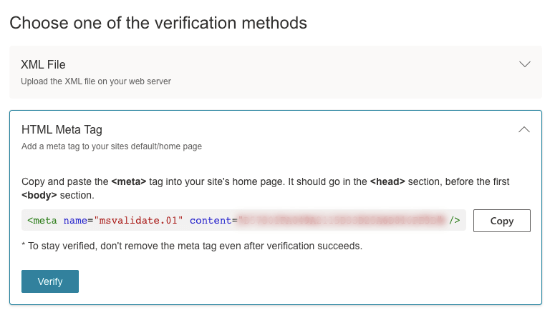
Ora, installate e attivate il plugin WPCode Free sul vostro sito web.
Dopo l’attivazione, è necessario visitare la pagina Code Snippets ” Header & Footer e aggiungere il codice copiato in precedenza nella casella “Header”.

Non dimenticate di fare clic sul pulsante “Salva modifiche” per memorizzare le modifiche.
Usare i sitemap XML per far crescere il vostro sito web
Ora che avete inviato la sitemap XML a Google e Bing, vediamo come utilizzarla per il vostro sito web.
Innanzitutto, è necessario tenere presente che la sitemap XML non migliora le classifiche di ricerca. Tuttavia, aiuta i motori di ricerca a trovare i contenuti, a regolare il crawl rate e a migliorare la visibilità del sito web nei motori di ricerca.
È necessario tenere sotto controllo le statistiche della sitemap in Google Search Console. Può mostrare gli errori di crawl e le pagine escluse dalla copertura di ricerca.
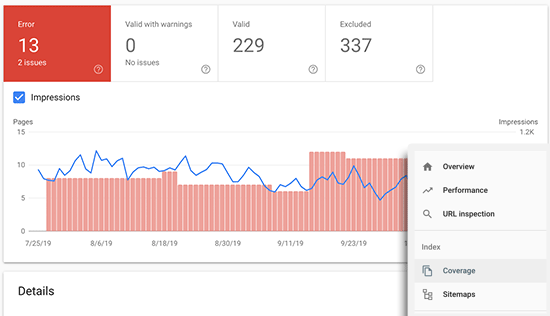
Sotto i grafici, è possibile fare clic sulle diverse tabelle.
Qui è possibile visualizzare quali URL effettivi sono stati esclusi o non indicizzati da Google.

Normalmente, Google può decidere di ignorare i contenuti duplicati, le pagine prive di contenuto o con contenuto molto scarso e le pagine escluse dal file robots.txt o dai meta tag del sito.
Tuttavia, se il numero di pagine escluse è insolitamente alto, si consiglia di controllare le impostazioni del plugin SEO per assicurarsi che non sia stato bloccato alcun contenuto.
Per maggiori dettagli, consultate la nostra guida completa a Google Search Console per i principianti.
Speriamo che questo articolo vi abbia aiutato a conoscere le sitemap XML e a creare una sitemap XML per il vostro sito WordPress. Potreste anche voler consultare la nostra guida su come creare una sitemap multilingue in WordPress e le nostre scelte di esperti sui migliori strumenti di ricerca di parole chiave per scrivere contenuti migliori.
Se questo articolo vi è piaciuto, iscrivetevi al nostro canale YouTube per le esercitazioni video su WordPress. Potete trovarci anche su Twitter e Facebook.





Christopher Ebling
I only get options that say Dashboard Search Console and Go Premium I don’t see site map as an option how do I get it to do the site map so I have to pay the 97$
WPBeginner Support
Hey Christopher,
The option is moved to the advanced settings pages. Please see our updated guide on setting up Yoast SEO plugin and check step 3 which shows how to enable advanced settings and then step 9 which shows how to enable sitemaps.
Admin
Deepika Bisht
Yoast seo best way to create a good sitemap for a wordpress blog. Thanks for share it.
Mahmoud
i already have my sitemap XML , but i need to regenerate it .
what is the best way to do that ?
chittara
OMG it helped me loads and loads…thanks a lot
Shane Jackson
Thanks, this helped a lot!
Vin Boris
Very informative content. It is a good information with good knowledge, my most of doubts get cleared with this.
Justin Lanouette
how do you add a sitemap to wordpress.com sites?
Abdul Asif
can you explain, what must be included in sitemaps, whether all posts, category, tags etc..
Angela - CRD Founder
Amazing article! no-one could explain the Sitemap thing better than you. Thanks so much!! I’ve just followed all the steps (for the verification method, I chose “Domain Name Provider”, by the way)
So my website is roughly a month old and I’ve only just added the YOAST plugin and sitemap today. How much time does it take for Google to recognize it? Right now, I have this message in my Webmaster Tools:
“Error details: 1 Errors, 0 Warnings.
“We encountered an error while trying to access your Sitemap. Please ensure your Sitemap follows our guidelines and can be accessed at the location you provided and then resubmit.
“Network unreachable: Network unreachable”
What does it mean, please?
andy
thanks! this is great!
Valentine
Nothing to comment again because the process was straight forward. Thanks so much
WPBeginner Support
You are welcome.
Admin
Toma
First off, I`d like to say “thank you” for all your support and guidance to the new WP users.
I`ve created a sitemap, however Google is telling me that the URL is restricted by robots.txt
My robots.txt file look like this:
User-agent: *
Disallow: /
Sitemap: http://www.example.com/sitemap.xml
Checks:
sitemap.xml has been tested and is working as expected.
I`ve checked the site variants (www and non-www)
I understand that in WP Admin, under Search Engine Visibility it is possible to encourage search engines to index the site. My understanding is that doing so will modify the robots.txt file and will allow all robots to crawl my site – including the “bad” crawlers (I`ve read this on other tutorials).
Any further assistance will be greatly appreciated.
Regards,
Toma.
WPBeginner Support
Your Robots.txt file is blocking search engines. You need to change that immediately. Try this and then check again with Google webmaster tools.
User-agent: *
Disallow:
SITEMAP: http://www.example.com/sitemap.xml
Admin
danielsonjosh
this is fabulous!!!!!! great work
Abhinav
The yoast sitemap page is showing “Warning: Class __PHP_Incomplete_Class has no unserializer in /home/content/n3pnexwpnas01_data02/78/3160178/html/wp-content/object-cache.php on line 520”, followed by url’s. This is the case with sitemap_index as well as sitemaps contained within. Sometime it shows right format and sometimes the similar error for the same post/page/index sitemap. How can I fix this?
Quanglepro
Hello,
Your tip is very detail. But can i ask some more thing. I am new wordpresser from Viet Nam, I meet the problem with sitemap of Yoast seo.
After Save changes the Sitemap of Yoast, Then i go to Google console to add ” sitemap_index.xml ” for index.
After add sitemap_index.xml, It just show the blue color culumn, dont have any red color column for Index.
It is PASS or FAIL? How can i know google console indexed my sitemap or Not index for this case.
Nice day
Quangle
WPBeginner Support
If there is an error, Google will display the error. Otherwise you should see your sitemap accepted.
Admin
Quanglepro
It is done sir. After 2 days, it will be indexed. Google doesnt index immediately.
Nice day.
ArParvez
dear sit iam seeing ur video and tutorial, using how to seo wordprees ytoast. i have done it, but when i try to see xml file it tell error/page not found but when i test this link on google sitemap it say no error found, but its empty. what should i do. and also i am getting problem using wordprees, i think i have done some mistake to install wp. i have install via Android phn.and sometime when i want to delete some plugin it tell error database,can u guys help me to reinstall wordprees pls it will be greatfull. tnx
WPBeginner Support
It seems that WordPress is unable to connect to database server. Please take a look at our guide on how to fix the error establishing database connection in WordPress.
Alessio
Hi guys,
do I still need a dedicated plugin for the sitemap or does the latest version of WP come with something for the sitemap too?
WPBeginner Support
WordPress does not come with built-in sitemaps.
Admin
suji
After installing Yoast plugin i got the below msg!
The plugin Yoast SEO has been detected. Do you want to import its settings into All in One SEO Pack?
wat do i need to do?
WPBeginner Support
You need to disable All in One SEO plugin. Yoast SEO and All in One SEO are both SEO plugins. Having both of them enabled on your site may cause serious problems.
Admin
Suji
Hi,
Thanks for the reply. I disabled All in one SEO plugin. I have one more query. Can you pls answer it?
I have already verified my site using HTML file upload method, so now how can i generate a sitemap using Yoast SEO plugin?
Summer Breeze
Thank you so much! This was immensely helpful.
Jacqui Rawson
Thanks guys!
This was really helpful.
You’re making my stress levels deflate immensely with all your assistance on getting my site all SEO set up.
Cheers
Emma
Thank you for the step-by-step instructions – really helped me to understand WP and Google further.
Keep up the good work!
Abhyank
“If you have a sitemap that is located on example.com/sitemap.xml, your sitemap is not being generated by our Yoast SEO plugin. It is probably generated by Google XML Sitemaps or another XML sitemaps plugin. Please disable other sitemap plugins and remove any sitemap files via FTP before enabling the sitemaps in our plugin.”
How do i get around this?
WPBeginner Support
Simply go to your plugins page. See if you have a plugin installed that adds XML sitemap. If you do, then disable that plugin.
Admin
Abhyank
I really can’t figure out if any of my plugins are making a sitemap, i don’t think i have installed any that do. So terribly confused.
WPBeginner Support
Then try disabling all plugins except Yoast SEO. Then try go to sitemaps, if you don’t see the message then this means one of the plugin was causing that. You can then activate plugins one by one and visit the sitemaps screen to see if the error reappears. Do that until you find the plugin causing it.
On the other hand if you see the message even after deactivating all plugins, then it could be your WordPress theme or a manually created file on your server.
Yuvraj Khavad
Hello,
Thanks for this tutorial.
Very mush informative post.
Thanks
Yuvraj Khavad
Dawit
Thanks! very helpful.
Erin
Thank you for this informative article.
I have notice that some of my pages are not included in the sitemap generated in WordPress using the Yoast SEO – XML sitemap tool. Is there a way to manually enter the missing pages or to update the sitemap to include these pages?
Galib
Really easy to follow and create a site map!!
Jo
Thank you! I think I have created what was needed and it was easy. Instructions were clear and easy to follow, thank you.
Annika
Hi there,
I’ve read through a lot of pages trying to explain what you did, but seriously, yours is BY FAR the best. Easy to understand, one-by-one explanations. Thanks for your great help, you probably just saved me hours and hours of work.
Cheers,
Annika
WPBeginner Support
Thanks, we are glad you found it helpful.
Admin
Magaly
Great info, very useful!

Now will wait for Google Analitycs to do his work
Suraj
Very helpful article n screenshots makes it easy to understand!! Thanks for posting!!
kksilvery
Hi,
It was easy to understand. My question is , how can i edit my blog current sitemap?
Regards,
kksilvery.
Kay Collier
Thank you once again for more valuable information.
Josh Watson
SUPER useful article! I really appreciate the info! This saved me so much time and hassle. I had looked at a couple other guides and they were just confusing.
I used this on my site and it really saved us!
Shailesh Jangra
Hi Syed Balkhi,
Great post over sitemaps. I have one question for you.
I have sitemap_index.xml for my website (without www ) but now I set my website to www version. I can see that all pages automatically changes with www version but sitemap_index dosn’t. Any specific reason.
Also it shows nothing on but at sitemap_index.xml page I have complete sitemap.
What is the mistake?
WPBeginner Support
Since you have set your website URL on www your sitemap will be published on the same URL.
Admin
zeeshan khan
My site map shows the staticstics of web page but not show the staticstics of images. why not show image in my site map help me please.
Tom Horn
Whenever I submit the sitemap this is the message I get:
“Your Sitemap does not contain any URLs. Please validate and resubmit your Sitemap.”
Can you tell me what to do? Thanks.
Leo
I am having serious problems regarding sitemaps for a few months ago. I am using a wordpress hosted by godaddy. I’ve installed SEO by Yoast and did the sitemaps tutorial you had. Site’s is connecting, the sitemap is there, but the specific links (posts, pages, author, etc) are pending.
We wait 48 hours, and none. We try it so many times, re-submitted, and yet Google search console is not crawling our site correctly.
I don’t know what to do! Does it has to do with our theme? Godaddy told us there’s nothing blocking it on their side. And every time i look on the internet, many people are still having the same issue. Noticed that our site is working correctly and so are the feeds. But we are not crawling anything… Please if somebody already solved this, tell us, maybe someone else will going to solve this terrible issue
Jess @ Make and Do Crew
Thanks for this! It’s the clearest explanation I’ve seen. How long does it take for Google to crawl it? I can’t seem to get to that final visual you showed with the total number of pages and images indexed, although I haven’t gotten any sort of message that google is still working on it. Like, should I check back tomorrow? And if so, can you tell me exactly what to click on to find the confirmation that the site has been fully crawled? Thanks again!
WPBeginner Support
Give it at least 48 hours.
Admin
John
Thanks for the info. As an addition: if the sitemap url gives a 404 then try lowering the default value of 1000 for the maximum number of lines. Worked for me.
Tamsin
Thank you for your solution. I changed the default value to 200 and it works! I have spent the last week trying to get my head around this stuff being a complete beginner. You have saved my sanity.
Israel
please, after i clicked on the XML Sitemap
what i got is error,
Error 404 Not Found
Oops! We couldn’t find this Page.
Please check your URL or use the search form below.
Please what can i do to get mu sitemp. thanks
Taranpreet Singh
same problem is with me. have you solved the problem.
Austin
Same issue, no sitemap on my free .wordpress.com site. How do we fix this or create one?
ramin ziafat
thank you it was great
surya teja
thank you for the great article .
i am having a problem . i am using free wordpress of name ( free domain sitename.wordpress.com ) i am not understanding how to add the site map at now
WPBeginner Support
Please see our guide on the difference between WordPress.com and WordPress.org.
Admin
Nitika
nice article! apart from this do we need to enter google authorisation code?
Leo
Hi,
Thank you so much for the easy-to-follow instructions and well explained topic about sitemaps.
My question is How to add a ‘single’ page or post which displays all your posts. I hope you got what i mean.
I saw a blog, at the bottom of the page there is a clickable link called ‘sitemap’. when you click it, it will bring you to a page containing all the published post or articles or i suppose, “the sitemaps”.
How can i do these type of ‘clickable link’???
Thank you very much.
WPBeginner Support
You can try this plugin.
Admin
Naveen
Nice article ! But when i submitted the sitemap, it is showing 0 url submitted at the dashbard area
Kris letcher
Thanks for the concise information.
Kris
Deb Slater
Wow. wpbeginner is the very best instruction I have found for my WordPress site. Thank you.
Harrison Okoyibo
I just want to say a big “THANK YOU” for your efforts providing the internet wordpress users with useful, and relevant information, articles, and tutorials. Wishing you and your team more of God’s blessing. Shalom!
Luigi
Thank you for this tutorial! It was really helpful!
Ana
Thank you for your tutorial and info. It really helped me with the sitemap! Great job!
Ezekiel
Thank you for this explanation. I am indeed grateful for it.
Your tutorials in this site has always been helpful
Kaleem Ullah
Your Sitemap appears to be an HTML page. Please use a supported sitemap format instead. need help